
Today, a random sampling of rampaging robots from non-Hanna-Barbera television shorts, mostly from the 1960’s. We’ll begin by showcasing some contributions from Sam Singer’s “Courageous Cat and Minute Mouse”, then visit with Popeye, Underdog, Tennessee Tuxedo, Deputy Dawg, and the Mighty Heroes.
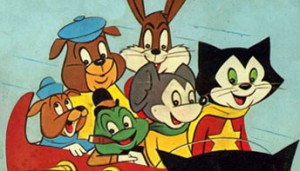 The Case of the Robot (Courageous Cat and Minute Mouse, release date unknown), though lacking in much of any real action, is a somewhat superior episode of the series, generating a few smiles. Animation seems a cut above most installments (even if inking still remains thick and sometimes awkward), suggesting the presence of Shamus Culhane or Sid Marcus, who I believe worked for Singer for a short time. The grounds of a professor’s laboratory are well posted with signs to provide quiet to the “genius at work”, including signs reading “hush-hush”, and “Shut you mouth!”. Inside, a small moustached Germanic-accented professor (using the same Dal McKennon voice better known as Professor Dingledong in the Woody Woodpecker series) creates a towering steel robot ten times his size, with a light bulb for a nose, multi-level satellite-dish style antenna on its head, and an elongated blocky body. Its head seems to vary from short to shot, starting out as a cylinder turned sideways with antennas for ears like Rosey the robot, but changing into more squared-off block form in many shots. The professor begins with a little education, teaching the robot to spell “Cat”. He then takes a quantum leap for lesson two, giving the robot a math equation to solve which is so long, it takes close to a minute to even state it. The robot has ample time to scratch his head in confusion, then attempts to repeat the equation while pondering it, only to find himself stumped and forced to admit to the Professor, “I forgot the question”. The Professor reduces the lesson to the level of “What’s two plus two?”, and gets every answer but the right one. The Professor drops a hint that it’s what golfers yell on the fairways, and gets a response of “Seven?” The Professor finally gives him the answer, then grades the robot as a “genius”, declaring he has now taught the robot “everything I know.”
The Case of the Robot (Courageous Cat and Minute Mouse, release date unknown), though lacking in much of any real action, is a somewhat superior episode of the series, generating a few smiles. Animation seems a cut above most installments (even if inking still remains thick and sometimes awkward), suggesting the presence of Shamus Culhane or Sid Marcus, who I believe worked for Singer for a short time. The grounds of a professor’s laboratory are well posted with signs to provide quiet to the “genius at work”, including signs reading “hush-hush”, and “Shut you mouth!”. Inside, a small moustached Germanic-accented professor (using the same Dal McKennon voice better known as Professor Dingledong in the Woody Woodpecker series) creates a towering steel robot ten times his size, with a light bulb for a nose, multi-level satellite-dish style antenna on its head, and an elongated blocky body. Its head seems to vary from short to shot, starting out as a cylinder turned sideways with antennas for ears like Rosey the robot, but changing into more squared-off block form in many shots. The professor begins with a little education, teaching the robot to spell “Cat”. He then takes a quantum leap for lesson two, giving the robot a math equation to solve which is so long, it takes close to a minute to even state it. The robot has ample time to scratch his head in confusion, then attempts to repeat the equation while pondering it, only to find himself stumped and forced to admit to the Professor, “I forgot the question”. The Professor reduces the lesson to the level of “What’s two plus two?”, and gets every answer but the right one. The Professor drops a hint that it’s what golfers yell on the fairways, and gets a response of “Seven?” The Professor finally gives him the answer, then grades the robot as a “genius”, declaring he has now taught the robot “everything I know.”
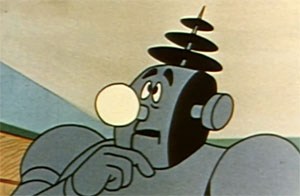 But the Professor reminds the robot that he is the master. “No, no. I am master”, replies the Robot, “Dumbkoff, I am the master” repeats the Professor. A sock in the head by the robot’s steel hand settles the argument. “Hello, Master”, responds the Professor meekly. The robot suddenly develops big ideas, and decides to become the richest Burgermaster in the world – by ripping bank vaults out of buildings. The Professor phones in a call to police that the robot is out of control, having to clarify that the robot is not “crooked” in appearance, but a crook, and is “made of steel and he steals.” Courageous and Minute are finally called in on the case, as the robot stomps down a city street carrying one of the huge vaults on his back. Courageous reaches for his trusty cat-gun, setting it for its dependable lasso mode – but for once in the series, the trigger jams, and the weapon won’t fire. Minute asks if Courageous would mind if Minute uses his back-up weapon – a water pistol. “Not at all”, Courageous responds gracefully. As did Ruff in Hanna-Barbera’s “Planet Pirates”, Minute fires, and rusts the robot solid. The Professor arrives with congratulations, and inquires how they did it. Minute demonstrates with a shot of the water pistol in the Professor’s face. “You shouldn’t have done that”, says Courageous to Minute. “Now the Professor is rusting.” Without explanation as to whether the Professor is a robot, or if there is something more than water in Minute’s gun, the Professor turns a rusty brown and cannot move. Courageous and Minute carry the immobile Professor off in the final shot, with the Professor commenting to the audience, “Such a dumkoff!”
But the Professor reminds the robot that he is the master. “No, no. I am master”, replies the Robot, “Dumbkoff, I am the master” repeats the Professor. A sock in the head by the robot’s steel hand settles the argument. “Hello, Master”, responds the Professor meekly. The robot suddenly develops big ideas, and decides to become the richest Burgermaster in the world – by ripping bank vaults out of buildings. The Professor phones in a call to police that the robot is out of control, having to clarify that the robot is not “crooked” in appearance, but a crook, and is “made of steel and he steals.” Courageous and Minute are finally called in on the case, as the robot stomps down a city street carrying one of the huge vaults on his back. Courageous reaches for his trusty cat-gun, setting it for its dependable lasso mode – but for once in the series, the trigger jams, and the weapon won’t fire. Minute asks if Courageous would mind if Minute uses his back-up weapon – a water pistol. “Not at all”, Courageous responds gracefully. As did Ruff in Hanna-Barbera’s “Planet Pirates”, Minute fires, and rusts the robot solid. The Professor arrives with congratulations, and inquires how they did it. Minute demonstrates with a shot of the water pistol in the Professor’s face. “You shouldn’t have done that”, says Courageous to Minute. “Now the Professor is rusting.” Without explanation as to whether the Professor is a robot, or if there is something more than water in Minute’s gun, the Professor turns a rusty brown and cannot move. Courageous and Minute carry the immobile Professor off in the final shot, with the Professor commenting to the audience, “Such a dumkoff!”
You can see it on this page.
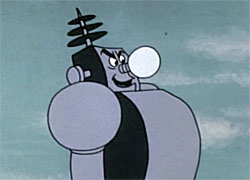 In contrast, The Case of the Roaming Robot practically isn’t an episode at all, but a retread of re-used animation from the preceding cartoon. This time, Courageous’s usual nemesis, the Frog, reconstructs the robot from stolen plans, to steal for him. The same robbery and vault-carrying shots are repeated. Courageous tries a few shots from his cat-gun, but can’t find a setting that has any effect – and entirely forgets to use Minute’s secret weapon of the water pistol. The Professor is called in for help, and solves the problem in an instant with a new invention – a push-button personality changer. One press, and the robot turns on the Frog, and carries his to justice in police headquarters. That’s pretty much it, and more typical of what passed for a plot in an average Sam Singer cartoon.
In contrast, The Case of the Roaming Robot practically isn’t an episode at all, but a retread of re-used animation from the preceding cartoon. This time, Courageous’s usual nemesis, the Frog, reconstructs the robot from stolen plans, to steal for him. The same robbery and vault-carrying shots are repeated. Courageous tries a few shots from his cat-gun, but can’t find a setting that has any effect – and entirely forgets to use Minute’s secret weapon of the water pistol. The Professor is called in for help, and solves the problem in an instant with a new invention – a push-button personality changer. One press, and the robot turns on the Frog, and carries his to justice in police headquarters. That’s pretty much it, and more typical of what passed for a plot in an average Sam Singer cartoon.
You can see it on this page.
 Robot Popeye (King Features/Paramount, Popeye – Seymour Kneitel, dir.) – Bluto (aka Brutus) is tinkering with a “Mechanical Man Kit – Easy to Assemble.” It’s never explained if these kits are designed to customize to the user’s needs and design, or just come ready-made this way, but Bluto’s result is a blocky, angular approximation of the squint-eyed sailor – complete with a voice-simulator operated by remote control that allows Bluto to make it speak any number of Popeye’s favorite phrases (“Well blow me down”, “I yam what I yam”, etc.) and any other custom dialogue to meet the occasion. Animation of the robot uses an interesting shortcut, where mouth-movements are achieved by painting the entire jaw on a separate layer of cels to be overlaid over those of the stationary head – but with total disregard for the slight change in paint shading visible on camera from the diminishment of color caused to the lower drawing by being seen through the overlaid upper cel. In other words, both layers of cels are painted with the identical shade of paint, rather than painting the upper drawing in a shade darkened to match the lower drawing which is being seen though an extra layer of plastic – leaving the overlaid jaws standing out like a sore thumb (a common phenomena often seen in early 30’s black and white animation). It is an interesting effect, as it makes the robot version of Popeye seem all the more artificial and mechanical, as if his jaw is definitely a separate part from his face! Leave it to Kneitel to figure out how to turn a budget-cutter to best advantage.
Robot Popeye (King Features/Paramount, Popeye – Seymour Kneitel, dir.) – Bluto (aka Brutus) is tinkering with a “Mechanical Man Kit – Easy to Assemble.” It’s never explained if these kits are designed to customize to the user’s needs and design, or just come ready-made this way, but Bluto’s result is a blocky, angular approximation of the squint-eyed sailor – complete with a voice-simulator operated by remote control that allows Bluto to make it speak any number of Popeye’s favorite phrases (“Well blow me down”, “I yam what I yam”, etc.) and any other custom dialogue to meet the occasion. Animation of the robot uses an interesting shortcut, where mouth-movements are achieved by painting the entire jaw on a separate layer of cels to be overlaid over those of the stationary head – but with total disregard for the slight change in paint shading visible on camera from the diminishment of color caused to the lower drawing by being seen through the overlaid upper cel. In other words, both layers of cels are painted with the identical shade of paint, rather than painting the upper drawing in a shade darkened to match the lower drawing which is being seen though an extra layer of plastic – leaving the overlaid jaws standing out like a sore thumb (a common phenomena often seen in early 30’s black and white animation). It is an interesting effect, as it makes the robot version of Popeye seem all the more artificial and mechanical, as if his jaw is definitely a separate part from his face! Leave it to Kneitel to figure out how to turn a budget-cutter to best advantage.
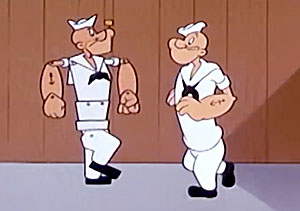 Scriptwise, the story is largely a remake of Famous’s 1940’s episode, “Puppet Love”, with Bluto using the robot to make Popeye’s life miserable. First, he lets the robot walk by the real Popeye, uttering to him a friendly “Ahoy, Matey.” Popeye responds in kind with a friendly greeting to “Popeye” – then goes through the same angst as in Fleischer’s “Hello, How Am I?”, insisting that this can’t be, since he is the real Popeye – while the robot has quickly disappeared from the scene. Leaving Popeye in the depths of a reality check, Bluto next sends the robot into Roughhouse’s Diner, where Wimpy is facing the usual problem of no cash and no hamburgers. The robot greets the two of them, then tells Roughhouse to serve up to Wimpy all the hamburgers he can eat, and charge it to Popeye’s account. Bluto knows this will set Popeye back a pretty penny. Finally, he sends the robot to Olive’s house, an hour early for their dinner date. The robot barges in, criticizes Olive’s food as “poison” even before it’s cooked, and pulls a chair out from under Olive at the dinner table – then cools off her temper with a glass of water thrown in her face. When the real Popeye shows up, he gets a bashing from Olive with an umbrella to teach him some manners, and an ultimatum never to return. Bluto finally reveals the secret to Popeye, laughing that he hasn’t had this much fun since when he first saw “Frankenstein”. Without even needing the spinach, Popeye grabs from Bluto the robot’s control box, and decides to find out what his own twisting of the dials can do. The robot assumes a threatening pose against its creator, repeating the words over and over “Get Brutus”. “No, no!”, says the villain, and runs for it, closely pursued by the robot – the final results of which are never seen on screen. Some time later, Bluto is gone, and explanation has been provided to Olive, who has invited Popeye for dinner after all. They each open a can of spinach, pouring out the contents on their plate – then offer the cans to a third sitting for dinner – the robot, who chows down on the tasty tin. Popeye ends with his song, “I’m glad he’s mechanical and not so romantical, like Popeye the Sailor Man.”
Scriptwise, the story is largely a remake of Famous’s 1940’s episode, “Puppet Love”, with Bluto using the robot to make Popeye’s life miserable. First, he lets the robot walk by the real Popeye, uttering to him a friendly “Ahoy, Matey.” Popeye responds in kind with a friendly greeting to “Popeye” – then goes through the same angst as in Fleischer’s “Hello, How Am I?”, insisting that this can’t be, since he is the real Popeye – while the robot has quickly disappeared from the scene. Leaving Popeye in the depths of a reality check, Bluto next sends the robot into Roughhouse’s Diner, where Wimpy is facing the usual problem of no cash and no hamburgers. The robot greets the two of them, then tells Roughhouse to serve up to Wimpy all the hamburgers he can eat, and charge it to Popeye’s account. Bluto knows this will set Popeye back a pretty penny. Finally, he sends the robot to Olive’s house, an hour early for their dinner date. The robot barges in, criticizes Olive’s food as “poison” even before it’s cooked, and pulls a chair out from under Olive at the dinner table – then cools off her temper with a glass of water thrown in her face. When the real Popeye shows up, he gets a bashing from Olive with an umbrella to teach him some manners, and an ultimatum never to return. Bluto finally reveals the secret to Popeye, laughing that he hasn’t had this much fun since when he first saw “Frankenstein”. Without even needing the spinach, Popeye grabs from Bluto the robot’s control box, and decides to find out what his own twisting of the dials can do. The robot assumes a threatening pose against its creator, repeating the words over and over “Get Brutus”. “No, no!”, says the villain, and runs for it, closely pursued by the robot – the final results of which are never seen on screen. Some time later, Bluto is gone, and explanation has been provided to Olive, who has invited Popeye for dinner after all. They each open a can of spinach, pouring out the contents on their plate – then offer the cans to a third sitting for dinner – the robot, who chows down on the tasty tin. Popeye ends with his song, “I’m glad he’s mechanical and not so romantical, like Popeye the Sailor Man.”
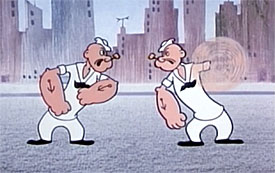 Seeing Double (King Features/Rembrandt Films, Popeye, Gene Deitch, dir.), takes a similar idea in an entirely different direction, for an action/adventure angle. The film begins innocently enough, with Olive (as seemed to be the dream of every woman of the time, without regard for the current trends against animal cruelty) eyeing a mink stole in a department store window, with a price tag of $2,000. “Isn’t that a gorgeous fur?”, she says to Popeye. The sailor answers, “Yeah, and so’s the price. C’mon. I’ll buy ya a gorgeous hamburger.” Meanwhile, at a sinister laboratory hideout, two thug henchmen are busy in a meeting with a tall moustached ringleader who talks like James Cagney, but also happens to be a mad scientist. The scientist is revealing his latest and greatest creation – a robot, who just happens to be a dead ringer for Popeye. Coincidence, or is the scientist taking advantage of the reputation of Popeye’s strength? We’ll never know, as the three never refer to the real Popeye by name to indicate any knowledge of the sailor. “Is it animal or vegetable?” asks one of the henchmen. “Ugliest brute I’ve ever seen”, remarks the other. A demonstration has the robot walk right through a solid wall, then take a hail of bullets from a machine gun of the scientist, to demonstrate he is 100% bullet-proof. And, he has the strength of 50 men. With this robot, the scientist claims they can do anything – and proves it, with a daring bank holdup, the robot again walking through the wall, then using the equivalent of Popeye’s twisker punch to break down the vault door. A guard’s shots serve as no deterrent, as the robot just keeps on coming, and knocks the guard out. A police artist sketches the thief’s description as given by the guard, including such features as a pugnacious jaw and huge tattooed forearms, and comes up with a perfect likeness of Popeye. The real Popeye is quickly arrested (though he at first wonders if the charge is merely for singing too loud). The real charge is the robbery, and Olive arrives at the jail to make things worse, believing that Popeye pulled the robbery to get the money for the mink stole. Popeye insists he is “innocenk”, and when word of a second robbery by a culprit of the same description reaches the station, despite Popeye having been locked in the slammer at the time of its commission, it is obvious that something nefarious is afoot. Determined that no one can impersonate him and get away with it, Popeye busts jail, straight through the wall like his counterpart (though a bit messier than the robot’s clean slice-through method).
Seeing Double (King Features/Rembrandt Films, Popeye, Gene Deitch, dir.), takes a similar idea in an entirely different direction, for an action/adventure angle. The film begins innocently enough, with Olive (as seemed to be the dream of every woman of the time, without regard for the current trends against animal cruelty) eyeing a mink stole in a department store window, with a price tag of $2,000. “Isn’t that a gorgeous fur?”, she says to Popeye. The sailor answers, “Yeah, and so’s the price. C’mon. I’ll buy ya a gorgeous hamburger.” Meanwhile, at a sinister laboratory hideout, two thug henchmen are busy in a meeting with a tall moustached ringleader who talks like James Cagney, but also happens to be a mad scientist. The scientist is revealing his latest and greatest creation – a robot, who just happens to be a dead ringer for Popeye. Coincidence, or is the scientist taking advantage of the reputation of Popeye’s strength? We’ll never know, as the three never refer to the real Popeye by name to indicate any knowledge of the sailor. “Is it animal or vegetable?” asks one of the henchmen. “Ugliest brute I’ve ever seen”, remarks the other. A demonstration has the robot walk right through a solid wall, then take a hail of bullets from a machine gun of the scientist, to demonstrate he is 100% bullet-proof. And, he has the strength of 50 men. With this robot, the scientist claims they can do anything – and proves it, with a daring bank holdup, the robot again walking through the wall, then using the equivalent of Popeye’s twisker punch to break down the vault door. A guard’s shots serve as no deterrent, as the robot just keeps on coming, and knocks the guard out. A police artist sketches the thief’s description as given by the guard, including such features as a pugnacious jaw and huge tattooed forearms, and comes up with a perfect likeness of Popeye. The real Popeye is quickly arrested (though he at first wonders if the charge is merely for singing too loud). The real charge is the robbery, and Olive arrives at the jail to make things worse, believing that Popeye pulled the robbery to get the money for the mink stole. Popeye insists he is “innocenk”, and when word of a second robbery by a culprit of the same description reaches the station, despite Popeye having been locked in the slammer at the time of its commission, it is obvious that something nefarious is afoot. Determined that no one can impersonate him and get away with it, Popeye busts jail, straight through the wall like his counterpart (though a bit messier than the robot’s clean slice-through method).
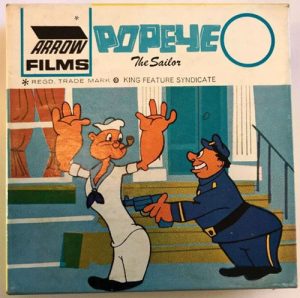
The box for “Seeing Double” on 8mm!
p>
An odd and funny coda to these two episodes shows up as a throwaway gag in an unknown episode of Samurai Jack. Various villains are sharing notes on how tough Jack is, comparing war wounds incurred in past battles with the named hero. Among them, for one shot, appears a robotic Popeye, who remarks, ‘He busted me eye.”
 March of the Monsters (Total Television, Underdog, 3/10/64 – one of only four episodes produced as stand-alone stories instead of as four-chapter serials (presumably as pilots for the series). Sweet Polly Purebread is in the middle of her newscast, when her story shifts to an item about strange noises outside of town. As she listens, the sounds grow louder and louder, like approaching footsteps. It is an invasion of mechanical robots from outer space, with large blocky heads and eyes that alternate flashing red to emphasize their rampage. Pulling the roof off of the TV studio, one of the monsters seizes Sweet Polly, who broadcasts a call for help to Underdog (not yet her usual chorus of “Oh where, oh where has my Underdog gone?”). Listening to a transistor radio, our hero, as Shoe Shine Boy, hears the call, and another phone booth blows up as he makes a quick costume change. He flies into the monster holding Polly, but finds these creatures are tough, as he fails to make a dent, the metal instead bending his wrist. He has to shift into pile-driver mode of attack, using both fists for rapid alternating blows. The force puts the monster into jittering vibrations – which are having worse effect on Polly, held in the monster’s giant hand, than on the monster itself. Polly pleads for Underdog to save her first. Underdog agrees, “I forgot to remember that she would vibrate. I must get her down. The monster can wait.” It’s an easy task to open the grip of the robot’s fingers, and Polly is deposited in a position of safety – in a trash can on a nearby sidewalk.
March of the Monsters (Total Television, Underdog, 3/10/64 – one of only four episodes produced as stand-alone stories instead of as four-chapter serials (presumably as pilots for the series). Sweet Polly Purebread is in the middle of her newscast, when her story shifts to an item about strange noises outside of town. As she listens, the sounds grow louder and louder, like approaching footsteps. It is an invasion of mechanical robots from outer space, with large blocky heads and eyes that alternate flashing red to emphasize their rampage. Pulling the roof off of the TV studio, one of the monsters seizes Sweet Polly, who broadcasts a call for help to Underdog (not yet her usual chorus of “Oh where, oh where has my Underdog gone?”). Listening to a transistor radio, our hero, as Shoe Shine Boy, hears the call, and another phone booth blows up as he makes a quick costume change. He flies into the monster holding Polly, but finds these creatures are tough, as he fails to make a dent, the metal instead bending his wrist. He has to shift into pile-driver mode of attack, using both fists for rapid alternating blows. The force puts the monster into jittering vibrations – which are having worse effect on Polly, held in the monster’s giant hand, than on the monster itself. Polly pleads for Underdog to save her first. Underdog agrees, “I forgot to remember that she would vibrate. I must get her down. The monster can wait.” It’s an easy task to open the grip of the robot’s fingers, and Polly is deposited in a position of safety – in a trash can on a nearby sidewalk.
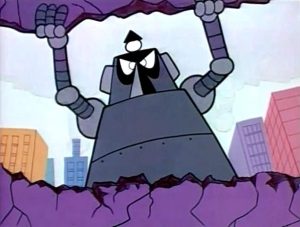 Underdog goes to work again with his pile-driver attack, and the monster begins to rattle and fall apart. Citizens below dodge the falling metal components, shouting “It’s raining locomotives!” One large portion of the robot falls directly upon another citizen’s car, flattening it. The monster is dismantled, and while Polly tries to drum up the gratitude of the townsfolk (difficult to do when a car is smashed), she asks how Underdog plans to take care of the remaining monsters. Underdog hasn’t given it much thought, but another citizen has. A little professor, who claims to be a monster expert, appears on the scene, and indicates that inside the head of every robot is a glass tube, which is all the contraptions have for brains. He suggests that if some way could be thought of to break the glass, the monsters would be rendered helpless. Underdog is just the dog for the job, possessing a hi-fi voice that can produce an intense high-frequency capable of shattering glass. He lets loose with a howl of unknown levels, which causes Polly and the Professor to cover their ears, but the monsters to topple, dead in their tracks. Unfortunately, the howl has additional consequences. It breaks every window, street lamp, and mirror in the city, and even the grocer’s tall display of pickle jars. The populace comes complaining about the damages. Underdog responds, “I am a hero who never fails. I can’t be bothered with those details.” Polly again steps in to stubbornly defend Underdog to the citizens, who should be happy for being rid of the monsters, and decides to reward Underdog herself with a kiss. Underdog is not a romantic, and backs away, hopping to higher ground to escape Polly’s embrace. “True heroes are never paid, and I am the truest hero ever made.” He takes off into the sky, for his standard ending of being mistaken for bird, plane, and frog. As he crashes into a bell tower, he calls back his closing catch-phrase: “Not plane, nor bird, nor even frog. It’s just little ol’ me – Underdog.”
Underdog goes to work again with his pile-driver attack, and the monster begins to rattle and fall apart. Citizens below dodge the falling metal components, shouting “It’s raining locomotives!” One large portion of the robot falls directly upon another citizen’s car, flattening it. The monster is dismantled, and while Polly tries to drum up the gratitude of the townsfolk (difficult to do when a car is smashed), she asks how Underdog plans to take care of the remaining monsters. Underdog hasn’t given it much thought, but another citizen has. A little professor, who claims to be a monster expert, appears on the scene, and indicates that inside the head of every robot is a glass tube, which is all the contraptions have for brains. He suggests that if some way could be thought of to break the glass, the monsters would be rendered helpless. Underdog is just the dog for the job, possessing a hi-fi voice that can produce an intense high-frequency capable of shattering glass. He lets loose with a howl of unknown levels, which causes Polly and the Professor to cover their ears, but the monsters to topple, dead in their tracks. Unfortunately, the howl has additional consequences. It breaks every window, street lamp, and mirror in the city, and even the grocer’s tall display of pickle jars. The populace comes complaining about the damages. Underdog responds, “I am a hero who never fails. I can’t be bothered with those details.” Polly again steps in to stubbornly defend Underdog to the citizens, who should be happy for being rid of the monsters, and decides to reward Underdog herself with a kiss. Underdog is not a romantic, and backs away, hopping to higher ground to escape Polly’s embrace. “True heroes are never paid, and I am the truest hero ever made.” He takes off into the sky, for his standard ending of being mistaken for bird, plane, and frog. As he crashes into a bell tower, he calls back his closing catch-phrase: “Not plane, nor bird, nor even frog. It’s just little ol’ me – Underdog.”
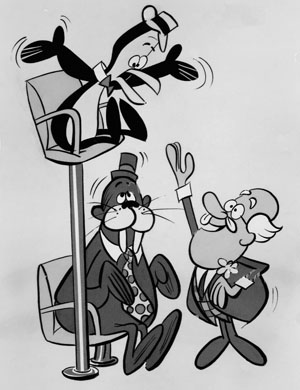 Robot Revenge (Total Television, Tennessee Tuxedo and His Tales, 2/5/66) – Stanley Livingston has been working the zoo animals hard in various clean-up duties, leaving them quite exhausted by nightfall. Tennessee and Chumley the Walrus are ready to settle down to well-needed rest, when their near-slumber is rudely interrupted by loud hammering from the neighboring animal house. They investigate the clamor, to find Baldy the Eagle and Yakety Yak laboring at the construction of, of all, things, a pair of robots, out of spare parts and scrap metal. They figure if they can build the mechanical men, the devices will shoulder any workload Stanley can dish out. Tennessee and Chumley break into fits of laughter, Tennessee insisting it is an impossibility, and that these hunks of tin could never do any work. Our heroes return to their beds, Tennessee dozing off on the final thought that the robot idea is “Ridiculous”. Anyone in the audience can see a dream sequence coming a mile away. Suddenly, Tennessee appears to be roused by more loud metallic sounds – but it is not hammering. Instead, their front door is broken down, by the intrusion of two all-metal men (tin can cylindrical variety, with large jaws and long thin cylindrical noses). The robots accuse Tennessee and Chumley of the charge of ridiculing robots, and pick up their bunk bed from each end, carrying it off with Tennessee and Chumley aboard, to face charges before the Regal Robot. Like a Little Audrey or Lulu episode from Famous Studios, they are transported by flying saucer to a land where robots rule and dwell, and brought into the courtroom of the Regal Robot – a more elderly model, wearing a crown and glasses to make him look learned. Without testimony or trial, he pronounces that the two are guilty of the ridiculing charge. He asks an all-robot jury what sentence is appropriate. Ten years at hard labor? “Not enough”, respond the jurors. 20 years?, 30? 40? “Still not enough”. Only one recourse is left. The ultimate sentence – throw them in the melting pot. “Have a heart”, begs Tennessee. “No robot has a heart”, responds the Regal Robot, pounding on his empty chest.
Robot Revenge (Total Television, Tennessee Tuxedo and His Tales, 2/5/66) – Stanley Livingston has been working the zoo animals hard in various clean-up duties, leaving them quite exhausted by nightfall. Tennessee and Chumley the Walrus are ready to settle down to well-needed rest, when their near-slumber is rudely interrupted by loud hammering from the neighboring animal house. They investigate the clamor, to find Baldy the Eagle and Yakety Yak laboring at the construction of, of all, things, a pair of robots, out of spare parts and scrap metal. They figure if they can build the mechanical men, the devices will shoulder any workload Stanley can dish out. Tennessee and Chumley break into fits of laughter, Tennessee insisting it is an impossibility, and that these hunks of tin could never do any work. Our heroes return to their beds, Tennessee dozing off on the final thought that the robot idea is “Ridiculous”. Anyone in the audience can see a dream sequence coming a mile away. Suddenly, Tennessee appears to be roused by more loud metallic sounds – but it is not hammering. Instead, their front door is broken down, by the intrusion of two all-metal men (tin can cylindrical variety, with large jaws and long thin cylindrical noses). The robots accuse Tennessee and Chumley of the charge of ridiculing robots, and pick up their bunk bed from each end, carrying it off with Tennessee and Chumley aboard, to face charges before the Regal Robot. Like a Little Audrey or Lulu episode from Famous Studios, they are transported by flying saucer to a land where robots rule and dwell, and brought into the courtroom of the Regal Robot – a more elderly model, wearing a crown and glasses to make him look learned. Without testimony or trial, he pronounces that the two are guilty of the ridiculing charge. He asks an all-robot jury what sentence is appropriate. Ten years at hard labor? “Not enough”, respond the jurors. 20 years?, 30? 40? “Still not enough”. Only one recourse is left. The ultimate sentence – throw them in the melting pot. “Have a heart”, begs Tennessee. “No robot has a heart”, responds the Regal Robot, pounding on his empty chest.
A squad of robots carries the bunk bed and our heroes out of the court, across an open grassy area, presumably on route to the melting pot. A small rain cloud gathers overhead. Tennessee sees an opportunity as the first raindrops fall, telling Chumley to make a break for it with him, and if the robots follow, they’ll rust. The boys run for their lives, but Chumley looks back to find these robots have licked this problem – as they are equipped with built-in umbrellas that pop out of their heads. Only one building presents itself as a hiding place – with a sign outside reading “The friendly robot with all the answers.” While the robots turn loose a pack of robotic dogs to aid in the pursuit, Tennessee and Chumley manage to duck inside and elude them, momentarily. Inside – you guessed it – a robotic clone of Phineas J. Whoopee! We get out usual educational moment on a mechanical 3DBB (3 dimensional blackboard) on how a heart works. Tennessee gets enough info that he thinks he can build a mechanical one, then exits with Chumley – one step ahead of the entry of the robot dogs, who pursue Whoopee around the room. Whoopee regrets that he didn’t have a chance to tell them that the heart doesn’t really control emotion or compassion, but figures they’ll learn this eventually – the hard way. Somehow eluding their pursuers, Tennessee and Chumley quickly throw together from parts obtained at a plumbing shop their own robotic heart (about ten times larger than could possibly fit into the Regal Robot’s chest). The Regal Robot himself and his troops arrive on the scene, set to make the arrest, but Tennessee shows him the heart he’s built for the ruler. He starts its engine, which pumps with increasing speed and fury. “Look out”, says the robot, as the heart explodes, its flying parts creating several substantial dents in the Regal Robot’s frame. The robot has had enough, and once again issues the order for the melting pot. Tennessee is seized by dozens of robotic claws, and cries out for help as he is shaken violently. It is actually only Chumley shaking him, waking him up for a new day in the real world. As Tennessee yawns and tries to get the sleep out of his eyes, the front door opens, and, much as in the dream, two robots enter. Tennessee’s eyes widen to five times their normal size, and he faints dead away. It is only Baldy and Yak, encased within the robot shells, who came to tell Tennessee that he was right about the robots not working – but still, they make great disguises.
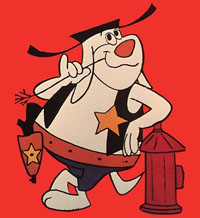 Science Friction (Terrytoons/CBS, Deputy Dawg, 3/2/63) – Deputy is a dog of many tasks. He simultaneously mows the lawn of the jailhouse while holding out a paintbrush to paint the jail – all the while complaining at also have to catch criminals in between. He literally mows down the sheriff coming around the corner, and gets docked two weeks pay to replace his devastated pants and boots. To make matters worse, he draws one of a Deputy’s most disagreeable assignments – eviction of a certain Dr. Molecule, who hasn’t paid his rent. The short-in-stature scientist occupies a small facility, where he spends his time mixing chemicals with results paralleling those of Poindexter in Felix the Cat – always an explosion. Deputy knocks on the door, and continues to knock on the scientist’s head once the door is opened, the little man complaining that continued knocking will drive him cuckoo. Deputy demands him out, but Molecule insists science is more important than rent, and calls for backup – a tin-can man, resembling a two-stage version of Friz Freleng’s three-stage pile of cylinders from Robot Rabbit. This robot, named Ludwig (any backhanded reference to a certain host of The Wonderful World of Color?), possesses eloquent speech abilities from his rigid, blocky jaw, sounding like a poor-man’s impression of Cary Grant. The robot comes to Molecule’s rescue, picking up Deputy in its iron claw, ushering him outside, then giving him a poke in the gut to knock him from the scene. Deputy returns, carrying a log as a battering ram.. But the robot demonstrates its great strength, by picking up the entire building and holding it over his head, causing Deputy to miss the front door, pass under the structure, and crash into a boulder. Deputy re-enters with a rifle, threatening to turn the robot into a metal sieve. The robot reminds him its not polite to point, and easily bends the gun barrel upward, causing it to shoot a hole in the plaster ceiling, its debris falling on Deputy’s head. The robot again deposits Deputy outside, in a trash can, and tells him to go somewhere and direct traffic. Eventually, Deputy finally comes up with a rare bright idea. He hooks several sticks of dynamite to a magnet, and tosses them in the window. The magnet is attracted to the robot, and sticks to him. Deputy stands ready to detonate the device with a dynamite plunger. Molecule finally relents, pleading for the life of his robot, who was only following orders. The scene fades back to the jailhouse, as the Sheriff congratulates Deputy on succeeding in his mission – without knowing all the details. An explosion inside the jail reveals that Molecule, chemistry set and all, is now occupying the jail cell. The Sheriff becomes furious at the thought that Molecule is now living rent-free at the county’s expense, but Deputy points out that his upkeep is being “worked for”. He points the Sheriff’s attention outside, where Ludwig now toils at all the tasks Deputy used to do, now himself also taking up Deputy’s line of complaints about the amount of labor: “What do I look like? A machine?”
Science Friction (Terrytoons/CBS, Deputy Dawg, 3/2/63) – Deputy is a dog of many tasks. He simultaneously mows the lawn of the jailhouse while holding out a paintbrush to paint the jail – all the while complaining at also have to catch criminals in between. He literally mows down the sheriff coming around the corner, and gets docked two weeks pay to replace his devastated pants and boots. To make matters worse, he draws one of a Deputy’s most disagreeable assignments – eviction of a certain Dr. Molecule, who hasn’t paid his rent. The short-in-stature scientist occupies a small facility, where he spends his time mixing chemicals with results paralleling those of Poindexter in Felix the Cat – always an explosion. Deputy knocks on the door, and continues to knock on the scientist’s head once the door is opened, the little man complaining that continued knocking will drive him cuckoo. Deputy demands him out, but Molecule insists science is more important than rent, and calls for backup – a tin-can man, resembling a two-stage version of Friz Freleng’s three-stage pile of cylinders from Robot Rabbit. This robot, named Ludwig (any backhanded reference to a certain host of The Wonderful World of Color?), possesses eloquent speech abilities from his rigid, blocky jaw, sounding like a poor-man’s impression of Cary Grant. The robot comes to Molecule’s rescue, picking up Deputy in its iron claw, ushering him outside, then giving him a poke in the gut to knock him from the scene. Deputy returns, carrying a log as a battering ram.. But the robot demonstrates its great strength, by picking up the entire building and holding it over his head, causing Deputy to miss the front door, pass under the structure, and crash into a boulder. Deputy re-enters with a rifle, threatening to turn the robot into a metal sieve. The robot reminds him its not polite to point, and easily bends the gun barrel upward, causing it to shoot a hole in the plaster ceiling, its debris falling on Deputy’s head. The robot again deposits Deputy outside, in a trash can, and tells him to go somewhere and direct traffic. Eventually, Deputy finally comes up with a rare bright idea. He hooks several sticks of dynamite to a magnet, and tosses them in the window. The magnet is attracted to the robot, and sticks to him. Deputy stands ready to detonate the device with a dynamite plunger. Molecule finally relents, pleading for the life of his robot, who was only following orders. The scene fades back to the jailhouse, as the Sheriff congratulates Deputy on succeeding in his mission – without knowing all the details. An explosion inside the jail reveals that Molecule, chemistry set and all, is now occupying the jail cell. The Sheriff becomes furious at the thought that Molecule is now living rent-free at the county’s expense, but Deputy points out that his upkeep is being “worked for”. He points the Sheriff’s attention outside, where Ludwig now toils at all the tasks Deputy used to do, now himself also taking up Deputy’s line of complaints about the amount of labor: “What do I look like? A machine?”
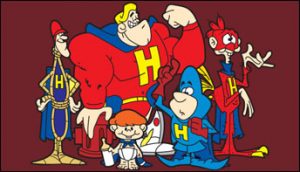 The Junker (Terrytoons/CBS, The Mighty Heroes, 11/12/66 – Ralph Bakshi, dir.). pits the heroes against the proprietor of Goodhaven’s local junkyard, where, in a secret lair built underneath the lot, the moustached fiend in a battered top hat and raggedy clothes creates an army of steel robots in the form of junkyard dogs. Their jaw-action is not stop, and dozens of them are sent out into the city, to devour and bring back all of the city’s steel, so that the Junker can corner the market on the commodity. Soon, the robots are snapping off street lightpoles at the root, chomping down automobiles, and ganging up in a group to devour from one end to the other Goodhaven’s river suspension bridge. The usual star-spangled stock animation sends a call for help to the Mighty Heroes – their leader. Diaper Man (a super-powered baby who uses his bottle as primary weapon and back-up power source from its milk, having much the same effect upon him as Popeye’s spinach), Strong Man (your usual big guy for the heavy work, with a Gomer Pyle voice read), Rope Man (a sailor by day, who when out of uniform reveals that he is mostly composed of a living coil of rope with human head, hands and feet attached), Tornado Man (a weatherman, with the power to convert into a spinning whirlwind with tornado force), and Cuckoo Man (the least well thought-out member of the team, a pet shop owner who has little more to offer for super powers than an awkward power of flight, and a knack for taking the lumps). The heroes make an awkward aerial entry that brings down the outward wall of an apartment building, causing one of the tenants to comment, “With heroes like this, who needs villains?” The quintet engage the marauding robot dogs, with little effect but to take their share of painful nips. The Junker sees opportunity, and remotely summons all the robots back to his junkyard, as bait for the Heroes to follow.
The Junker (Terrytoons/CBS, The Mighty Heroes, 11/12/66 – Ralph Bakshi, dir.). pits the heroes against the proprietor of Goodhaven’s local junkyard, where, in a secret lair built underneath the lot, the moustached fiend in a battered top hat and raggedy clothes creates an army of steel robots in the form of junkyard dogs. Their jaw-action is not stop, and dozens of them are sent out into the city, to devour and bring back all of the city’s steel, so that the Junker can corner the market on the commodity. Soon, the robots are snapping off street lightpoles at the root, chomping down automobiles, and ganging up in a group to devour from one end to the other Goodhaven’s river suspension bridge. The usual star-spangled stock animation sends a call for help to the Mighty Heroes – their leader. Diaper Man (a super-powered baby who uses his bottle as primary weapon and back-up power source from its milk, having much the same effect upon him as Popeye’s spinach), Strong Man (your usual big guy for the heavy work, with a Gomer Pyle voice read), Rope Man (a sailor by day, who when out of uniform reveals that he is mostly composed of a living coil of rope with human head, hands and feet attached), Tornado Man (a weatherman, with the power to convert into a spinning whirlwind with tornado force), and Cuckoo Man (the least well thought-out member of the team, a pet shop owner who has little more to offer for super powers than an awkward power of flight, and a knack for taking the lumps). The heroes make an awkward aerial entry that brings down the outward wall of an apartment building, causing one of the tenants to comment, “With heroes like this, who needs villains?” The quintet engage the marauding robot dogs, with little effect but to take their share of painful nips. The Junker sees opportunity, and remotely summons all the robots back to his junkyard, as bait for the Heroes to follow.
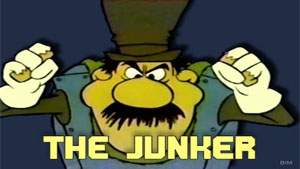 Once they are within his gates, the Junker smashes Strong Man by dropping a wrecking ball upon him, driving him into the underground lair. The rest of the Heroes follow, except for Diaper Man, who is flipped by a stray metal bar hit by the wrecking ball into a “steel girdle” of a trap, as he gets stuck in the holes of the crane girder controlling the wrecking ball. The heroes below are dragged into a large metal boiler tank, and the Junker seals them in with a steel lid. The boiler is then placed into a metal press, where it is compressed by several blows into an almost flattened state. The Junker invites his robots to look what he’s made for them – a “Hero sandwich”. The dogs begin to chow down through the outer shin of boiler steel, soon to be munching on the Heroes themselves. Diaper Man, still stuck above ground, manages to get a few swallows from his milk bottle for extra strength, then easily bursts his bonds. He zooms into the lair below, conking the Junker with a powerful blow, and calling, “Up and at ‘em, heroes.” The remaining Heroes exert an amassed strength inside the compressed boiler, and finally burst free. The battle with the robots is on again, but the tide begins to turn. Tornado Man hides in an oil drum, and when two dogs approach, asks them if they’ve had an oil change lately, squirting a coat of it all over them from the funnel of his tornado whirl. The oil catches fire from the dogs’ electrical sparking, disintegrating the two mechanical mutts. Diaper Man lures two more into the machine press, flattening them, then tells the audience “This is stamp out robots week.” More and more robots are destroyed, and Strong Man can finally turn his attention to capturing the Junker himself. But the Junker decides to “give them the slip”, pulling out a grease gun, and squirting Strong Man’s toes with it. The hero slips, and keeps sliding, colliding with a row of the pillars providing ceiling support for the underground lair. The steel ceiling begins to buckle and collapse. An exterior shot shows the entre towering supply of junk in the upper yard falling into the ground below fence level, while four of the heroes rise into the skies from the caverns below, carrying away the Junker to safety – and incarceration. One of the heroes asks where Tornado Man went, and Diaper Man provides the answer, telling them to look down. Tornado Man is busy planting a row of trees where the junkyard had once stood, providing Goodhaven with a new and peaceful public park.
Once they are within his gates, the Junker smashes Strong Man by dropping a wrecking ball upon him, driving him into the underground lair. The rest of the Heroes follow, except for Diaper Man, who is flipped by a stray metal bar hit by the wrecking ball into a “steel girdle” of a trap, as he gets stuck in the holes of the crane girder controlling the wrecking ball. The heroes below are dragged into a large metal boiler tank, and the Junker seals them in with a steel lid. The boiler is then placed into a metal press, where it is compressed by several blows into an almost flattened state. The Junker invites his robots to look what he’s made for them – a “Hero sandwich”. The dogs begin to chow down through the outer shin of boiler steel, soon to be munching on the Heroes themselves. Diaper Man, still stuck above ground, manages to get a few swallows from his milk bottle for extra strength, then easily bursts his bonds. He zooms into the lair below, conking the Junker with a powerful blow, and calling, “Up and at ‘em, heroes.” The remaining Heroes exert an amassed strength inside the compressed boiler, and finally burst free. The battle with the robots is on again, but the tide begins to turn. Tornado Man hides in an oil drum, and when two dogs approach, asks them if they’ve had an oil change lately, squirting a coat of it all over them from the funnel of his tornado whirl. The oil catches fire from the dogs’ electrical sparking, disintegrating the two mechanical mutts. Diaper Man lures two more into the machine press, flattening them, then tells the audience “This is stamp out robots week.” More and more robots are destroyed, and Strong Man can finally turn his attention to capturing the Junker himself. But the Junker decides to “give them the slip”, pulling out a grease gun, and squirting Strong Man’s toes with it. The hero slips, and keeps sliding, colliding with a row of the pillars providing ceiling support for the underground lair. The steel ceiling begins to buckle and collapse. An exterior shot shows the entre towering supply of junk in the upper yard falling into the ground below fence level, while four of the heroes rise into the skies from the caverns below, carrying away the Junker to safety – and incarceration. One of the heroes asks where Tornado Man went, and Diaper Man provides the answer, telling them to look down. Tornado Man is busy planting a row of trees where the junkyard had once stood, providing Goodhaven with a new and peaceful public park.
The Junker would make one more appearance, in The Paper Monster (2/25/67), in which he calls upon his robot dogs to gather for him all the newspapers in town, mixing them together in a vat of paste and goo into a living creature of monstrous proportions made of paper. Exactly how this creation is so strong when made of a tearable substance is never explained, but Diaper Man eventually manages to get the thing soaking wet, indicating there’s nothing weaker than wet paper. After the monster is defeated, the Heroes prepare to leave, but Diaper Man lingers behind, engrossed in reading the Sunday funny papers.
Next Time: a survey of several series that originally passed under this writer’s radar.


 Charles Gardner is an animation enthusiast who toils by day as a member of LA Law – but by nights and weekends indulges in classic jazz and ragtime as a performer; and studies classic Hollywood cartoons… maybe a little too much.
Charles Gardner is an animation enthusiast who toils by day as a member of LA Law – but by nights and weekends indulges in classic jazz and ragtime as a performer; and studies classic Hollywood cartoons… maybe a little too much.


































































































































































I take it you are only looking at appearences by robots in various series, not series where the robots are the main characters ( Astro Boy, Gigantor, Frankenstein Jr, etc). I was hoping you would be looking at them as well as characters like the Robotic Stooges and Dynomutt. Inspector Gadget was a cyborg,not a robot.
That’s next week.
As a lifelong birdwatcher, I’ve always felt that Cuckoo Man was, on the contrary, one of the most cleverly conceived of all superhero characters. As brood parasites, cuckoos are hated by other birds. One often sees them ganging up to harass a male cuckoo, and while this is going on, the female will be laying her eggs in the other birds’ nests. Cuckoo Man fulfills a similar function by distracting the bad guys and “taking the lumps,” thereby enabling the other heroes to get the job done.
“March of the Monsters” is an atypical Underdog adventure, but also one of the funniest. I love his callous indifference to the collateral damage he’s caused. “I am a hero who never fails! I can’t be bothered by those details!” should have been a catchphrase throughout the series. I’ve quoted it myself many times over the years.
Strange how Ludwig the robot sounds like Cary Grant. Dayton Allen must have been working his way through his entire repertoire of impersonations.
Another King Features Popeye cartoon from 1960 with a robot theme is “Popeye the Popular Mechanic” (Jack Kinney, dir.). After Olive has delivered an ultimatum to improve his housekeeping or get another girlfriend, Popeye is inspired by a “magzgazine” article to build himself a mechanical “soivink”. The resulting robot, named Mac, cleans the house, cooks up some crêpes suzettes au flambé, then tucks Popeye into bed and rocks him to sleep. (The decidedly subpar animation in this cartoon gives the impression that Popeye’s disembodied head is rolling around on the bed as Mac rocks it.) While the sailor dozes, Brutus removes Mac’s chest plate and crosses his wires, causing the robot to go berserk. Popeye subdues Mac by the simple expedient of slamming his fist down on top of the robot’s head, just once, without the benefit of any spinach. After Popeye restores the wiring, Mac is good as new and proceeds with the housework, putting Brutus out on the curbside with the rest of the rubbish.
I always thought Mr. Whoopee was a dirty old man.
As bad as those 1960’s Popeye cartoons are, the best of them are the ones done by the old Paramount crew. Their animation skills are so much better than the ones done by Jack Kinney, Gene Deitch, and the rest.
Some other robots with Felix in 1960:
SUPERTOY-Frquent bestie and charge Poindexter invents a small, curvy, “female” robot toy that soon as it’s working, while the Professor’;s asleep in his room elsewhere, dominates everything in the story-:she carries the Prof.out with Felix in tow, catching on to it, back and forth across various city and rural backgrounds, before crashing right into the professor’s lab! Our boys then get tied up (literally) by the little metallic brat, who then goes into another room to do its work, coming out as a BIG toy, with a partner (great voicing of both by Jack Mercer, who had to play everyone in this series). They then argue and beat each other up. Just then, the Professor, from his bedroom, peeks out, and congratulates them,. But the surprise is, we see him in the room,walking out, and it turns out he was away! The “Prof.” whom we’d been seeing all along was a dummy!
Similiarly, “Cleaning Hpuse”(AKA)”Rosie Robot”,with no JETSON relation (THE JETSONS, besides being from a pre-crossover era, wasn’t even around yet), has Felix finding himself behind in his cleaning, when a nice, fancy salesman sells him for a day, a robot maid, named Rosie, who then gets to work, but either overdoes it (giving him a bath) or misunderstanding, literally, our hero’s request (gives him a hot dish, but it’s not food..it”s you get it).Once understsanding, instead of getting the meal when it’s hot, she lets Felix hold the food. It then explodes. She has to clean the mess.Fortunately the salesman’s back, though Felix and Rosie do a la Porky Pig and Pierre Termite in 1947’s “PEST THAT CAME TO DINNER:”(dir.Art Davis)-gang up on the salesman (in a different way than Porky and the termite did to the smiling dog Sureshot, whose desk Pierrre the Termite ate and they open a shop.Here Felix simply has Rosie kick out our salesman, followed by Felix’s trademark laugh).
Finally, back to Felix and Poindexter, when he invents “The Strongest Robot in the world”, who proves itself that. The boys then have to chase the robot, gluing it,etc. This is one of a number of the 1960-61 episodes not intact, I can’t say anything more excvpet they implodfe the guy.
Also, at Hanna-Barbera in 1961, unless it’s already been covered, “Robot Plot”, has one of two rotating farmers, this sounding like Walter Brennan (!!) inventing a robot to catch Hokey and kid buddy Ding-a-Ling. Drawing a picture on paper, and inserting it straight into a slot of the robot, will set it in motion. Hokey and his young pal begin to investiem, it, it starts chase, they start running, then some chases,, Ding-a-Ling pounds the robot with a plank just when things seem wrong for our Phil Silvers wolf,. both of whom discover now that it was a robot, with the slot for target. Guess whose face Hokey draws?
Steve Carras